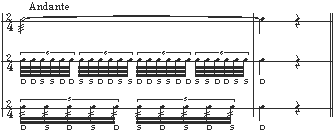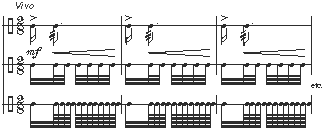|
THE ADVANTAGES OF MULTIPLE STROKE ROLL |
|
Although the roll is the most typical effect of most percussion instruments, it is always associated with the drum. This trend is also present in many Italian dictionaries; at the entry "roll" they say: "series of drum strokes" (Devoto/Oli), "sound of a drum" (Palazzi), ecc.
For experts, this definition would be more suitable: " the typical sound resulting from many percussion instruments, including the drum; it is also named rolling because of its particular effect.". In short, the roll is the technical means for percussion instruments to sustain the sound. The main features affecting the roll quality are: the speed of the hand movement, the number of strokes in each movement, the intensity and equality of the strokes and the vibration characteristics of the instrument. There are many types of roll; the single stroke roll and the double stroke roll are the most well-known and widely used. The single stroke roll is the result of a fast alternation of one stroke per hand, the double stroke roll is the result of a fast alternation of two strokes per hand. The single stroke technique is more used with long resonance instruments, like the timpani, as it is more powerful, whereas the double stroke is more used with short resonance instruments, like the drum. In the past, when the drums where made of natural leather and had high supports, like those immortalized by Rembrandt in its famous work Ronda di notte, evrything could be executed by means of the single and double strokes. Today this is no longer possible as the instruments are made of synthetic leather which has not the resonance of the natural leather. Both the single and double stroke rolls require a fast alternation of the hands to produce a continuous sound. This feature may cause unpleasant accentuation and loss of homogeneity, if the number of strokes per hand is not increased. Many performers talk of double stroke measured rolls; in fact what is measured is only the hand movements, as, in case of difficulties, they increase the strokes per hand unconsciously, to fill in the "gaps". Therefore, it is more advisable to slow down the hand movements intentionally and to increase the number of strokes adopting the multiple stroke roll which is more suitable for short resonance instruments because of its features (series of strokes per hand).  Let us analyse the following example: A rolled half note requires 12 movements of the hands to have 24 strokes with the double stroke technique. On the contrary, the multiple stroke technique makes it possible to obtain a 40 stroke roll with only 10 hand movements (4 strokes per hand) pp. 96-100 the “Il suono della percussione”. Needless to say that musical genres, like jazz or rock in its various expressions, provide more freedom of interpretation, therefore, the player can choose the technique he prefers according to his personal style. With regards to those genres which demand perfection, the proper technique must be adopted to have the effect desired by the author. Let us choose, as an example, a piece which has often been cause of embarrassment for both performers and teachers. I am referring to some 2/8 measures (Vivo “in one”), played with the drum, of the famous symphonic suite "Scheherazade" by N.R. Korsakov. The difficult point shows, for different measures, a 16th and a dotted eighth cut by three abbreviating lines: in short a roll formed by twelve 64ths. Instead of the 64th, many execute either the single stroke roll or the double stroke roll, depending on the speed of the execution; the result is 32nds which adapt to the general musical context but are not what the author wished. The reasons for a different executions (which is now considered normal) can be traced in a wrong interpretation of the abbreviations. Here is why. If a quarter note with three lines means eight 32nds an eighth with the same lines means eight 64ths. Therefore |

writing
incorrect performance
correct performance
|
In the multiple roll, which must not be exchanged for that which is called by many "dragged roll", a key role is played by the fingers which must exercise a light continuous pressure on the sticks to have very close bounce strokes.
Furthermore, the initial "start" accents must be avoided and the bounce strokes usually weaker, must be strengthened. Another element to be taken into consideration is that all rolls can be executed on two or more instruments. The execution on two instruments is called double roll, on three or four instruments the result is rolled chords. For the latter, two sticks per hand must be held, like for the keyboards. |